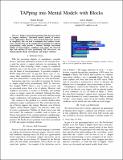Files in this item
TAPping into mental models with blocks
Item metadata
| dc.contributor.author | Rough, D. | |
| dc.contributor.author | Quigley, A. | |
| dc.date.accessioned | 2018-04-16T08:30:18Z | |
| dc.date.available | 2018-04-16T08:30:18Z | |
| dc.date.issued | 2017-10-10 | |
| dc.identifier | 252534733 | |
| dc.identifier | 2414d034-56c8-4e38-88dd-f355987bcc21 | |
| dc.identifier | 85048308003 | |
| dc.identifier | 000425946800028 | |
| dc.identifier.citation | Rough , D & Quigley , A 2017 , TAPping into mental models with blocks . in 2017 IEEE Blocks and Beyond Workshop (B &B) . , 8120429 , IEEE , pp. 115-116 , 2nd Workshop on Lessons and Directions for First Programming Environments , Raleigh , North Carolina , United States , 10/10/17 . https://doi.org/10.1109/BLOCKS.2017.8120429 | en |
| dc.identifier.citation | workshop | en |
| dc.identifier.isbn | 9781538624814 | |
| dc.identifier.isbn | 9781538624807 | |
| dc.identifier.other | Bibtex: urn:47669ba5bc22ec646be29525cd31d9fd | |
| dc.identifier.other | ORCID: /0000-0002-5274-6889/work/42734896 | |
| dc.identifier.uri | https://hdl.handle.net/10023/13137 | |
| dc.description.abstract | Trigger-Action Programming (TAP) has been shown to support end-users' rule-based mental models of context-aware applications. However, when desired behaviours increase in complexity, this can lead to ambiguity that confuses events, states, and how they can be combined in meaningful ways. Blocks programming could provide a solution, through constrained editing of visual triggers, conditions and actions. We observed slips and mistakes by users performing TAP with Jeeves, our domain-specific blocks environment, and propose solutions. | |
| dc.format.extent | 2 | |
| dc.format.extent | 427135 | |
| dc.language.iso | eng | |
| dc.publisher | IEEE | |
| dc.relation.ispartof | 2017 IEEE Blocks and Beyond Workshop (B&B) | en |
| dc.rights | © 2017, IEEE. This work has been made available online in accordance with the publisher’s policies. This is the author created, accepted version manuscript following peer review and may differ slightly from the final published version. The final published version of this work is available at https://doi.org/10.1109/BLOCKS.2017.8120429 | en |
| dc.subject | Cognition | en |
| dc.subject | Mobile computing | en |
| dc.subject | Jeeves | en |
| dc.subject | TAP | en |
| dc.subject | Blocks programming | en |
| dc.subject | Context-aware applications | en |
| dc.subject | Domain-specific blocks environment | en |
| dc.subject | Rule-based mental models | en |
| dc.subject | Trigger-action programming | en |
| dc.subject | Visual actions | en |
| dc.subject | Visual conditions | en |
| dc.subject | Visual triggers | en |
| dc.subject | Cognitive science | en |
| dc.subject | Programming | en |
| dc.subject | Smart phones | en |
| dc.subject | Usability | en |
| dc.subject | Visualization | en |
| dc.subject | H Social Sciences | en |
| dc.subject | QA75 Electronic computers. Computer science | en |
| dc.subject | QA76 Computer software | en |
| dc.subject | NS | en |
| dc.subject.lcc | H | en |
| dc.subject.lcc | QA75 | en |
| dc.subject.lcc | QA76 | en |
| dc.title | TAPping into mental models with blocks | en |
| dc.type | Conference item | en |
| dc.contributor.institution | University of St Andrews.School of Computer Science | en |
| dc.identifier.doi | 10.1109/BLOCKS.2017.8120429 |
This item appears in the following Collection(s)
Items in the St Andrews Research Repository are protected by copyright, with all rights reserved, unless otherwise indicated.

